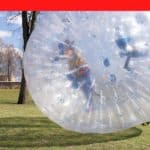For those who like to spend time out on the water, kayaking is a popular recreational activity.
Although they’re available in various styles, a kayak is traditionally a small, narrow watercraft which uses can sit or stand on as they paddle along in the water.
For some kayak owners, storing their craft isn’t difficult yet a common question that is often asked is – can kayaks be stored outside?
Storing your kayak outside is possible. However, there are various factors to consider when you do this. For example, finding shelter and using a protective cover, such as a tarpaulin, are highly recommended. Covering your yak is especially advised as it will prevent it from weather damage, dirt, sand and bugs, and animals hiding inside the cockpit area.
It is vital to take extra precautions to keep moisture out and prevent it from harmful UV rays.
Using a tarp is advised as a method to cover a kayak, but how beneficial and how you position the tarp varies.
If you position it like a tent over your vessel, any rain, snow, or other debris will easily slide off the cover.
Having the tarp directly on top of yak may lead to mold, discoloring, or other fungi developing on the hull (the bottom) as moisture can get through.
Therefore having an open end is recommended for your tarp to provide air circulation.
Why should I store my Kayak Outside?
Even though owning a kayak can bring plenty of joy and relaxation, you will want to make sure you get plenty of use out of your vessel.
So storing your yak should be a priority.
The material of a kayaks body, rotomolded polyethylene, is vulnerable and can be easily damaged if not stored and maintained properly.
The benefits of Storing a Kayak Outside
Depending on the type of kayak, it is commonly known for most users to store their yaks outside due to their size.
While inflatable and folding kayaks can easily be stored away, a traditional hard-shell kayak means outside storage is essential.
Storing the kayak outside means you will not be taking up any available indoor space.
Short-term and Long-Term Kayak Storage Tips
Add UV protection
Although your kayak might be covered up with the use of a tarp, applying a sun-protective spray can still benefit the longevity of your watercraft.
Clean it before storing
To prevent any dirt, water, or anything else damaging your kayak, it is advised you thoroughly clean it before storing it away.
To do this properly, you will need to use some mild soap and water and clean over the outside of the hull as well as inside the cockpit, so that all dirt and residue is completely gone.
It is also recommended you the seat and any other soft fabric compartments beforehand.
The entire yak needs to be dry before being stored away.
If you do not do this, then it could lead to fungus to grow eventually damaging your craft.
Cleaning your kayak after every use will maintain the durability of it in the long-term.
Lock it up
No matter what type of kayak you have or how or where you store it, it is advised to keep it securely locked away.
Even if you are not storing it away for a long period, keeping a lock of it will prevent any risk of theft.
Also, keeping the vessel out of view from passers-by is advised.
Maintain your accessories
Taking care of your paddle(s), float bags, spray skirt (or deck), bilge pump, and other accessories should be considered.
During long-term storage, remove these from your kayak, rinse them with fresh water and dry them thoroughly.
If it’s possible to store these indoors, then do so.
While maintaining a kayak isn’t on the level of a motorized vehicle or watercraft, there are other parts such as skegs, rudders, hatches, tow lines, and paddles that can fall into disrepair if they are not looked after.
Support
The average length of a kayak is 4.5 meters and supporting the hull whilst in storage is vital to the yak’s durability.
Ideally, the kayak should be supported on both its bow and stern, about one-third of the length in.
Padding
No matter how you store and elevate your craft, placing padding in-between the kayak and the straps will prevent any physical damage.
Using towels and any other soft material can be used as padding.
Storing a Kayak Outside – Do’s and Don’ts
Keep it out of sunlight
Although you will use a tarp to cover the kayak, choosing a shaded area to store it under will prove to be beneficial.
Pick a good location
Where you keep your kayak stored is important. Sunlight, rainwater, and heat and cold temperatures should be taken into consideration.
Regular exposure to any of these can lead to the hull material degrading over time.
Erect a loose tarpaulin
Suspending a tarp over the vessel will prevent any rainwater or any other damage from happening to the yak.
Attach the yak to a fence, pole, or wall
Threading a chain or a steel wire through the stern and bow hatches of the kayak, and chaining in on its side to a fence, pole or wall should keep it secure.
Don’t leave it on the ground
Most paddlers use a rack or some form of suspension to keep their kayak off the ground when stored outside.
Protecting the hull of the vessel is key to this.
It is advised to store the yak either on its side or upside down with the hull on top.
Alternatively, you can store it vertically.
Ultimately, keep it elevated and covered.
Hanging up the vessel with the use of a rope or to a bracket storage attached to an outside wall is an easy wall to keep the kayak elevated.
Kayak wall hangers, racks, and slings are easily available and are the perfect solution to storing your watercraft.
Don’t wrap the tarp tightly
Unfortunately, some people think wrapping the tarpaulin tightly around the kayak is a safe and secure way of storage.
However, this should not be done. Moisture can get underneath the tarp, creating mold and musk, eventually damaging the vessel.
Cover the interior
Because your tarp will have an open end for air circulation, it is possible for rodents can get inside the kayak.
A specially made cover that tightly wraps around this area is advised.
Furthermore, inserting some moisture-absorbing packets will prevent any interior damage.
Avoid pressure points
A lot of kayaks are made from rotomolded polyethylene, a tough, flexible, and relatively soft form of plastic.
Because of this, putting pressure on the body of a kayak can damage and deform the kayak.
Don’t strap it up too tight.
Consider the Weight
The use of grab or hanging loops is not advised.
Hanging your yak with these can be extremely dangerous and can warp the hull under its weight.
It is also less secure.
Therefore storing the kayak against a secure area such as a fence, wall, or pole is advised.
No matter how you elevate your craft, make sure the weight of the vessel is equally balanced.
Storing a Non-Plastic Kayak (Fiberglass, Carbon Fiber, Kevlar, Thermoform or Wood)
Most forms of kayaking including whitewater and recreational use plastic crafts.
However, for sea kayaking or kayak touring, there are different types of materials used; fiberglass, carbon fiber, Kevlar, and wood.
These materials are more expensive than rotomolded polyethylene plastic.
However, they are lighter, faster, and less durable.
The advantage of these composite materials is that they, for the most part, or deform or lose shape.
Nevertheless, fiberglass, carbon fiber, Kevlar, and wood kayaks should still be hung up when stored away.
They are as fragile as their plastic counterparts, if not more.
Thermoform kayaks have a sheet of ABS (a plastic alloy with styrene) and a top layer of acrylic.
Because of this, their outer layer usually has UV protection and is better resisting being warped during hot weather.
However, in cold weather, they are known to crack.
Therefore, a thermoformed kayak should be stored like a regular kayak.
Wooden yaks are unlikely to become deformed but should be protected and stored correctly.
Although some experts would not recommend doing it, it is possible to store a kayak outside.
However, it is vital to take precautions when doing so.
Remember to thoroughly clean it, safely and securely lock it up, protect it from extreme weather conditions, and carefully store it to prevent any longterm damage to the yak.
The last thing you want is your yak to become warped, deformed, discolored, or worse.
A kayak is a delicate watercraft made from plastic, and signs of wear and tear are commonplace.







